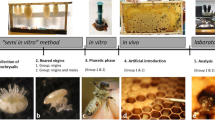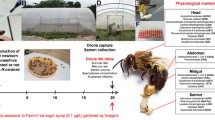Abstract
Mating in the mite Varroa destructor, an ectoparasite of the honeybee, takes place within the sealed brood cell of its host and is triggered by a female sex pheromone consisting of three fatty acids and their respective ethyl esters. In a laboratory bioassay, we observed interactions among offspring of a Varroa female at 11 days after host cell capping in the absence and in the presence of the sex pheromone and clearly demonstrated that male mites were not able to distinguish between receptive daughters and either older or immature and unreceptive females when exposed to the pheromone. In addition, mating attempts in the presence of the pheromone with otherwise receptive females were clearly of shorter duration and males often failed to select a receptive female. In order to evaluate the effect of pheromone exposure on successful copulations and the number of spermatozoa transferred under field conditions, we sprayed one of the pheromone components, oleic acid, on an empty brood comb before host egg-laying and Varroa infestation and counted the spermatozoa of daughter mites taken from this comb. We could show that the number of spermatozoa was indeed reduced, and 20 % of females lacked spermatozoa. Our results open up new possibilities and represent a promising step toward biological control of Varroa mites in beehives.




Similar content being viewed by others
References
Calderone NW, Lin S (2001) Arrestment activity of extracts of honey bee worker and drone larvae, cocoons and brood food on female Varroa destructor. Physiol Entomol 26:341–350
Calis JNM, Fries I, Ryrie SC (1999) Population modelling of Varroa jacobsoni Oud. Apidologie 30:111–124
De Jong D, De Jong PH, Goncalves LS (1982) Weight loss and other damage to developing worker honeybees from infestation with V. jacobsoni. J Apicult Res 21:165–216
De Miranda J, Genersch E (2010) Deformed wing virus. J Invertebr Pathol 103:S48–S61
Dietemann V, Pflugfelder J, Anderson D, Charrière JD, Chejanovsky N, Dainat B, de Miranda J, Delaplane K, Dillier FX, Fuchs S, Gallmann P, Gauthier L, Imdorf A, Koeniger N, Kralj J, Meikle W, Pettis J, Rosenkranz P, Sammataro D, Smith D, Yañez, Neumann P (2012) Varroa destructor: research avenues towards sustainable control. J Apicult Res 51(1):125–132. doi:10.3896/IBRA.1.51.1.15
Dillier FX, Fluri P, Imdorf A (2006) Review of the orientation behaviour in the bee parasitic mite Varroa destructor: sensory equipment and cell invasion behaviour. Rev Suisse Zool 113(4):857–877
Donzé G, Herrmann M, Bachofen B, Guerin PM (1996) Effect of mating frequency and brood cell infestation rate on the reproductive success of the honeybee parasite Varroa jacobsoni. Ecol Entomol 21:17–26
Fahle N, Rosenkranz P (2005) Mate choice in Varroa destructor: male mites prefer young females. In: IUSSI-Proceedings of the German Section Meeting at Halle, ISBN 3-901864-02-4
Francis RM, Nielsen SL, Kryger P (2013) Varroa-virus interaction in collapsing honey bee colonies. PLoS One 8(3):e57540
Frey E, Odemer R, Blum T, Rosenkranz P (2013) Activation and interruption of the reproduction of Varroa destructor is triggered by host signals (Apis mellifera). J Invertebr Pathol 113:56–62
Fries I, Camazine S, Sneyd J (1994) Population dynamics of Varroa jacobsoni: a model and a review. Bee World 75:5–28
Garrido C, Rosenkranz P (2004) Volatiles of the honey bee larva initiate oogenesis in the parasitic mite Varroa destructor. Chemoecology 14:193–197
Genersch E (2010) Honey bee pathology: current threats to honey bees and beekeeping. Appl Microbiol Biotechnol 87:87–97
Genersch E, von der Ohe W, Kaatz H, Schroeder A, Otten C, Büchler R, Berg S, Ritter W, Muehlen W, Gisder S, Meixner M, Liebig G, Rosenkranz P (2010) The German bee monitoring project: a long term study to understand periodically high winter losses of honey bee colonies. Apidologie 41:332–352. doi:10.1051/apido/2010014
Guzmán-Novoa E, Eccles L, Calvete Y, Mc Gowan J, Kelly PG, Correa-Benítez A (2010) Varroa destructor is the main culprit for the death and reduced populations of overwintered honey bee (Apis mellifera) colonies in Ontario, Canada. Apidologie 41:443–450
Harris JW, Harbo JR (1999) Low sperm counts and reduced fecundity of mites in colonies of honey bees (Hymenoptera: Apidae) resistant to Varroa jacobsoni (Mesostigmata: Varroidae). J Econ Entomol 92:83–90
Häußermann C (2011) Pheromonwahrnehmung und Repellenteffekte bei der Kopulation der Bienemilbe Varroa destructor. Bachelor thesis at the faculty of biology at the University of Hohenheim, p 23
Ifantidis MD (1983) Ontogenesis of the mite Varroa jacobsoni in worker and drone honey bee brood cells. J Apicult Res 22:200–206
Imdorf A, Charrière JD, Maquelin C, Kilchenmann V, Bachofen B (1996) Alternative varroa control. Am Bee J 136(3):189–193
Le Conte Y, Arnold G (1988) Etude du thermopreferendum de Varroa jacobsoni Oud. Apidologie 19:155–164
Le Conte Y, Sreng L, Trouiller J (1994) The recognition of larvae by worker honeybees. Naturwissenschaften 81:462–465
Le Conte Y, Ellis M, Ritter W (2010) Varroa mites and honey bee health: can Varroa explain part of the colony losses? Apidologie 41:353–363
Martin C, Provost E, Bagnères AG, Roux M, Clèment JL, Le Conte Y (2002) Potential mechanism for detection by Apis mellifera of the parasitic mite Varroa destructor inside sealed brood cells. Physiol Entomol 27:175–188
Rehm SM, Ritter W (1989) Sequence of the sexes in the offspring of Varroa jacobsoni and resulting consequences for the calculation of the developmental period. Apidologie 20:339–343
Rice ND, Winston ML, Higo HA (2004) Integrated Pest Management for the parasitic mite Varroa destructor (Anderson and Trueman) in colonies of honey bees (Apis mellifera). Am Bee J 144(10):791–795
Richards EH, Jones B, Bowman A (2011) Salivary secretions from the honeybee mite, Varroa destructor: effects on insect haemocytes and preliminary biochemical characterization. Parasitology 138:602–608
Rosenkranz P (1988) Temperaturpräferenz der Varroa-Milbe und Stocktemperaturen in Bienenvölkern an Tropenstandorten (Acarina: Varroidae/Hymenoptera: Apidae) Entomol Gener 14:123–132
Rosenkranz P, Engels W (1994) Genetic and environmental influences on the duration of preimaginal worker development in eastern (Apis cerana) and western (Apis mellifera) honey bees in relation to Varroatosis. Rev Brasil Genet 17:383–391
Rosenkranz P, Aumeier P, Ziegelmann B (2010) Biology and control of Varroa destructor. J Invertebr Pathol 103:96–119
Schatton-Gadelmayer K, Engels W (1988) Blood proteins and body weight of newly-emerged worker honeybees with different levels of parasitization of brood mites. Entomol Gener 14:93–101
Schneider P, Drescher W (1987) Einfluss der Parasitierung durch die Milbe Varroa jacobsoni aus das Schlupfgewicht, die Gewichtsentwicklung, die Entwicklung der Hypopharynxdrüsen und die Lebensdauer von Apis mellifera. Apidologie 18:101–106
Vetharaniam I (2012) Predicting reproduction rate of Varroa. Ecol Model 224:11–17
Wilkinson D, Smith GC (2002) A model of the mite parasite, Varroa destructor, on honeybees (Apis mellifera) to investigate parameters important to mite population growth. Ecol Model 148:263–275
Yang X, Cox-Foster D (2007) Effects of parasitization by Varroa destructor on survivorship and physiological traits of Apis mellifera in correlation with viral incidence and microbial challenge. Parasitology 134:405–412
Ziegelmann B, Lindenmayer A, Steidle J, Rosenkranz P (2013a) The mating behavior of Varroa destructor is triggered by a female sex pheromone. Part 1: preference behavior of male mites in a laboratory bioassay. Apidologie 44:314–323. doi:10.1007/s13592-012-0182-5
Ziegelmann B, Tolasch T, Steidle JLM, Rosenkranz P (2013b) The mating behavior of Varroa destructor is triggered by a female sex pheromone. Part 2: identification and dose-dependent effects of components of the Varroa sex pheromone. Apidologie 44:481–490. doi:10.1007/s13592-013-0198-5
Acknowledgments
We thank the Federal Ministry of Food, Agriculture and Consumer Protection for providing financial support (511-06.01-28-1-71.001-10).
Author information
Authors and Affiliations
Corresponding author
Additional information
Handling Editor: Günther Raspotnig.
Rights and permissions
About this article
Cite this article
Ziegelmann, B., Rosenkranz, P. Mating disruption of the honeybee mite Varroa destructor under laboratory and field conditions. Chemoecology 24, 137–144 (2014). https://doi.org/10.1007/s00049-014-0155-4
Received:
Accepted:
Published:
Issue Date:
DOI: https://doi.org/10.1007/s00049-014-0155-4




